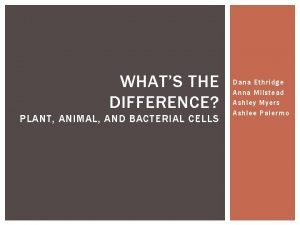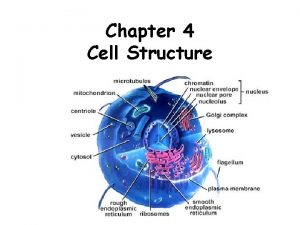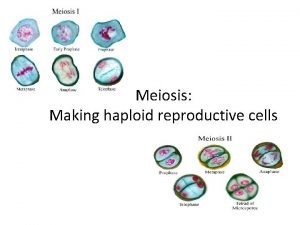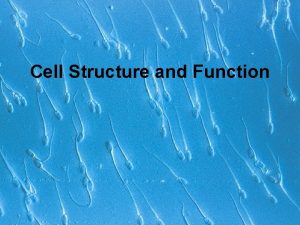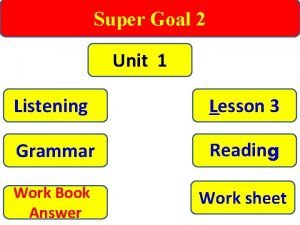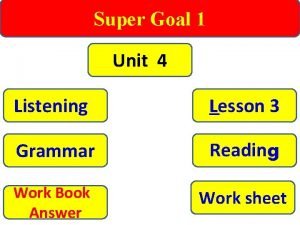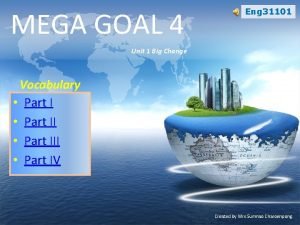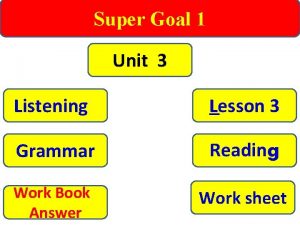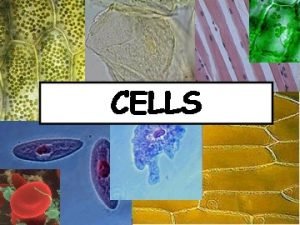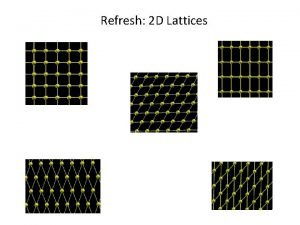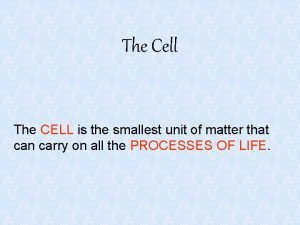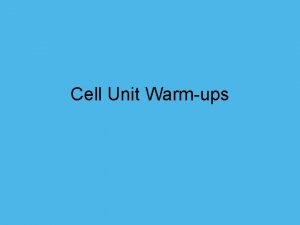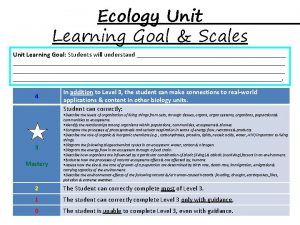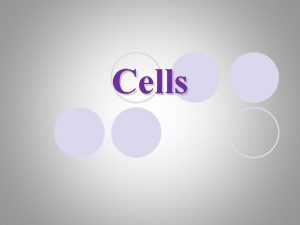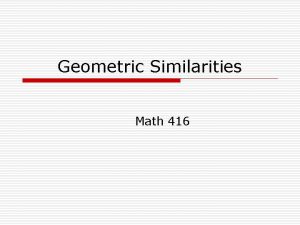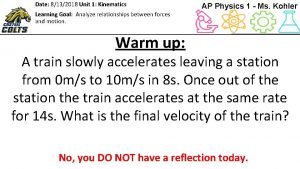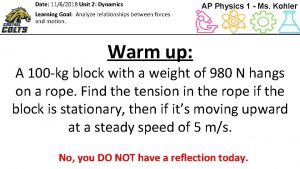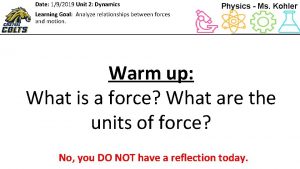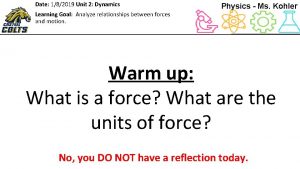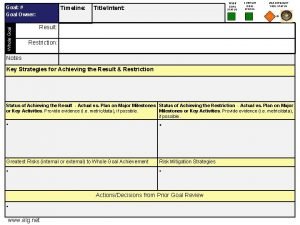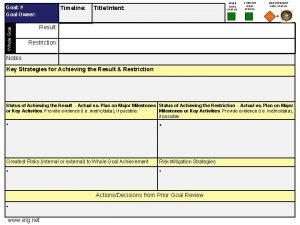UNIT 5 CELLS Learning Goal Analyze the similarities




































































- Slides: 68

UNIT 5: CELLS

Learning Goal Analyze the similarities and differences among (b) eukaryotic and prokaryotic cells

I. Prokaryotic vs Eukaryotic • There are two basic types of cells • Prokaryotic cells: • Pro – before • Karyotic – a nucleus • Do not have a nucleus • DNA is contained in a central location within the cell • Do not have any membrane bound organelles • Example Bacteria

• Eukaryotic cells • Eu – true • Karyotic – nucleus • Cells that have a nucleus • Contain membrane bound organelles • Are typically larger than prokaryotic cells


Learning Goals 1) Analyze the similarities and differences among (a) plant and animal cells 2) Describe the functions of all major organelles, including nucleus, endoplasmic reticulum, rough endoplasmic reticulum, Golgi apparatus, ribosome, mitochondria, microfilaments, lysosomes, centrioles, and cell membrane

II. Plant vs. Animal Cells • The cells of plants and animals share many similarities. However each type of cell has it own unique characteristics.

III. Organelles • Nucleus • Control center of the cell • Location of hereditary information (chromosomes) • Surrounded by nuclear envelope

• Nucleolus • Dense body in the nucleus • Site of ribosome production

• Nuclear envelope • Double membrane that surrounds the nucleus • Contains nuclear pores for RNA and ribosomes to move in and out of • The outer membrane is connected to the Endoplasmic Reticulum

• Cell wall – a rigid membrane around the cell; provides shape and support (plant cell only)

• Plastids (Plant cell only) • a group of structures (chloroplast, leukoplasts, and chromoplasts) used in photosynthesis and product storage • Have a double membrane and provide color and cellular energy

• Vacuoles • Storage sac for food and water • In plants there is a large central vacuole • In animals the vacuoles are small and numerous

• Cell membrane • A barrier surrounding the cell that allows some molecules to pass through

• Golgi Apparatus • Flattened membrane sacs for synthesis (making), packaging, and distribution

• Mitochondria • Rod-shaped double membranous structures where cellular respiration takes place • Makes energy for the cell to use

• Endoplasmic reticulum • Folded membranes having areas with and without ribosomes, used for transport of RNA and proteins • Rough ER • Contains ribosomes • Synthesizes (makes) proteins • Smooth ER • Contains no ribosomes • Synthesizes (makes) lipids

• Ribosomes • Structures that manufacture (make) proteins • Found attached to the ER and Free in the cytoplasm

• Centrioles (Animal cell only) • Short tubes necessary for cell reproduction in some animal cells

• Lysosomes • Spherical sac containing enzymes that digests dead organelles or unneeded material in the cell

• Cilia (Animal cell only) • Short – hair-like extensions on the surface of some cells used for movement and food gathering

• Flagella (animal cell only) • Long, whip-like extensions on the surface of some cells used for movement

• Cytoplasm • Jelly-like substance in the cell that contains various organelles

• Cytosol • Liquid-like substance that makes up part of the cytoplasm • Composed of water, proteins, dissolved ions and other small molecules

Learning Goal • Illustrate how all cells work together by describing the step -by-step process of the translation of an m. RNA into a protein. • Describe the process taken by organelles to appropriately package, label, and eventually export proteins made within a cell

IV. Protein Production and Shipping • Proteins have many different functions • Speed up chemical reactions • Provide color • Send chemical messages • Digest food

• Organelles involved in creating proteins • The Nucleus • Transcription • DNA is made into m. RNA

• Rough Endoplasmic Reticulum • The m. RNA leave the nucleus and attaches to a ribosome on the Rough ER • Ribosome • The m. RNA attaches to the smaller subunit and the larger subunit links the amino acids, a proteins monomer, together • t. RNA brings individual amino acids to the ribosomes to be added to the forming chain

• Golgi Apparatus • Sorts and packages proteins into transport or storage vesicles • A small storage sac enclosed in a membrane.

• Vesicles • Markers on the vesicles classify them as into 3 different categories • Exocytotic – leave the cell continuously • Example: antibodies used to fight infections • Secretory – are stored in the cell until they receive a signal to be released • Example: hormones • Lysosomal – contain digestive enzymes

• Vesicles containing compounds meant to be released from the cell bond with the cell membrane and release their contents outside of the cell.

IMPORTANT IDEA

Learning Goal • Contrast the structure and function of subcellular components of motility • Cilia • Flagella • Pseudopodia

V. Cellular Motility • Cilia • Short projections from cells • Have many different uses by a cell • In unicellular organisms • Used for locomotion (motile cilia), reproduction (non-motile cilia), sensing (non-motile cilia) • Humans • Clear mucus and debris from our airways (motile cilia) • Used to coordinate balance and movement in the inner ear • Move the female egg down the fallopian tube (motile cilia) • Distinguish light waves (non-motile)

• Flagella • Usually only 1 flagella on a cell, but can have multiple • Used only for movement

• Pseudopodia • False foot • They are amorphous, have no distinct shape • Usually found on large unicellular organisms (amoeba) • The organism can more in any direction due to the flexibility of the cell membrane •


Learning Goal • Explain how the cell membrane maintain homeostasis

VI. Maintaining Homeostasis • Hormones are chemical messengers that regulate some body functions in multicellular organisms • The movement of oxygen into cells and carbon dioxide out of cells • The control of an internal temperature • Regulation of fluids into and out of cells through the cell membrane • All of these function help cells maintain homeostasis (a stable internal environment)

Learning Goals • Explain how the cell membrane controls movement of substances both into and out of the cell • Describe and contrast these types of transport: diffusion, osmosis, facilitated diffusion, and active transport

VII. The Cell Membrane • The main purpose of the cell membrane is to regulate the movement of materials into and out of the cell • Semi-permeable • Only certain material can go through • Based on size and the charge of the particle

• The phospholipid bilayer • Composed of 2 layers containing phosphate groups for heads and two fatty acid tails • The heads are hydrophilic and are on the outside • The tails are hydrophobic and are on the inside

• The bilayer also contain proteins and cholesterol • Proteins • Structure and support • Moving substances across the membrane • Cholesterol • Support and structure • Phospholipids and proteins are free to move around • Allows membrane to flex and change shape


VIII. Passive Transport • In passive transport molecules move across the cell membrane without using energy • Move WITH the concentration gradient

• There are 3 types of Passive transport • 1) Diffusion • The process by which substances move DIRECTLY though the cell membrane

• 2) Facilitated diffusion • Molecules move across the membrane with the help of a carrier protein, channel protein

• 3) Osmosis • The movement of WATER across a membrane • There are three ways solutions can be classified based on the movement of water • 1) Hypotonic – the solution has a higher concentration of water

• 2) Hypertonic – a lower concentration of water

• 3) Isotonic • There is the same amount of water on both sides of the cell

• Plants and Osmosis • Plants in a hypertonic solution start to shrink and pull away from the cell wall, plasmolysis plant death • Isotonic solution cause the plant to wilt • Hypertonic solutions cause the plant cell to swell and become turgid, ridged.

• Water is constantly moving across the membrane even if the cell is in an isotonic solution

IX. Active Transport • Molecules moving AGAINST the concentration gradient • From an area of low concentration to an area of high concentration • REQUIRES ENERGY • Carrier proteins move specific molecules across the cell membrane • Fit only one type of molecule • Use ATP as their source of energy

• Exocytosis • Active transport that removes material from the cell • Waste materials, proteins, and fats • A vesicle from the Golgi Apparatus fuses with the membrane and the molecules are released

• Endocytosis • Brings material into the cell • The membrane folds itself around the substance and creates a vesicle • Some organisms obtain food this way (amoeba)


• Uses for active transport • Removing excess salt in marine organisms • Red blood cells use carrier proteins to transport molecules • Sodium Potassium pump, brings in potassium excretes slat

Learning Goal • Describe the basic process of mitosis

X. The Cell Cycle • The cell cycle is the sequence of stages through which a cell passes between one cell division and the next. • Most of the cell cycle is spent in interphase.

• Interphase has 3 parts • G 1 – the cell grows in size • S – DNA is synthesized (replicated/made) • G 2 – organelles are replicated and the amount of cytoplasm increases

XI. Mitosis • Happens in all body cells, somatic cells • A type of cell division that generates two identical daughter cells • During mitosis DNA is organized into threadlike material called chromosomes • The chromosomes are then divided and separated between the two new cells

• Uses for mitosis • Asexual reproduction • Allows multicellular organisms to grow and replace damaged cells

• Phases of Mitosis • Prophase • The nucleus of the cell organizes the chromatin material into thread-like structures call chromosomes • The nuclear envelope disappears

• Metaphase • The chromosomes attached at the centromere line up at the center of the cell.

• Anaphase • Chromosomes separate at the center and are pulled toward either end of the cell. A nuclear membrane forms around the chromosomes as they disorganize.

• Telophase • Chromatin again forms from the chromosomes, and a cell membrane begins to grow across the center between the two nuclei.

• Cytokinesis • The division of the cytoplasm • Happens during telophase • The final product is two identical daughter cells • Cell division is mitosis and cytokinesis together

 Animal and plant cell similarities
Animal and plant cell similarities 3 parts of the cell theory
3 parts of the cell theory All cells exhibit basic structural similarities
All cells exhibit basic structural similarities Plant vs animal cell venn diagram
Plant vs animal cell venn diagram Similarities between prokaryotic and eukaryotic cells
Similarities between prokaryotic and eukaryotic cells What was cells goal
What was cells goal Pns water view position
Pns water view position Tubular reabsorption
Tubular reabsorption Pineal gland
Pineal gland How are somatic cells different from gametes
How are somatic cells different from gametes Somatic vs germ cells
Somatic vs germ cells Chlorocruorin
Chlorocruorin What is eukarya
What is eukarya Prokaryotic cells vs eukaryotic cells venn diagram
Prokaryotic cells vs eukaryotic cells venn diagram Organelle trail
Organelle trail Masses of cells form and steal nutrients from healthy cells
Masses of cells form and steal nutrients from healthy cells Label
Label What cell type
What cell type Are red blood cells prokaryotic or eukaryotic
Are red blood cells prokaryotic or eukaryotic Nondisjunction in meiosis
Nondisjunction in meiosis Cells cells they're made of organelles meme
Cells cells they're made of organelles meme Cuadro comparativo de e-learning b-learning y m-learning
Cuadro comparativo de e-learning b-learning y m-learning 7 learning styles and vark similarities
7 learning styles and vark similarities Unit 6 review questions
Unit 6 review questions Minutes of lac session
Minutes of lac session Joy took the notes shown below while learning about cells
Joy took the notes shown below while learning about cells Super goal 2 unit 1
Super goal 2 unit 1 Super goal 2 unit 4 reading
Super goal 2 unit 4 reading Unit 1
Unit 1 Airplane camera orange umbrella eraser washing machine
Airplane camera orange umbrella eraser washing machine Cells are the smallest unit of life
Cells are the smallest unit of life Cells are the smallest unit of life
Cells are the smallest unit of life Types of unit cell
Types of unit cell Cells are the smallest unit of life
Cells are the smallest unit of life Cells are the basic unit of life true or false
Cells are the basic unit of life true or false Hình ảnh bộ gõ cơ thể búng tay
Hình ảnh bộ gõ cơ thể búng tay Ng-html
Ng-html Bổ thể
Bổ thể Tỉ lệ cơ thể trẻ em
Tỉ lệ cơ thể trẻ em Chó sói
Chó sói Tư thế worm breton
Tư thế worm breton Hát lên người ơi
Hát lên người ơi Các môn thể thao bắt đầu bằng tiếng nhảy
Các môn thể thao bắt đầu bằng tiếng nhảy Thế nào là hệ số cao nhất
Thế nào là hệ số cao nhất Các châu lục và đại dương trên thế giới
Các châu lục và đại dương trên thế giới Công thức tính thế năng
Công thức tính thế năng Trời xanh đây là của chúng ta thể thơ
Trời xanh đây là của chúng ta thể thơ Cách giải mật thư tọa độ
Cách giải mật thư tọa độ Phép trừ bù
Phép trừ bù độ dài liên kết
độ dài liên kết Các châu lục và đại dương trên thế giới
Các châu lục và đại dương trên thế giới Thể thơ truyền thống
Thể thơ truyền thống Quá trình desamine hóa có thể tạo ra
Quá trình desamine hóa có thể tạo ra Một số thể thơ truyền thống
Một số thể thơ truyền thống Cái miệng nó xinh thế
Cái miệng nó xinh thế Vẽ hình chiếu vuông góc của vật thể sau
Vẽ hình chiếu vuông góc của vật thể sau Biện pháp chống mỏi cơ
Biện pháp chống mỏi cơ đặc điểm cơ thể của người tối cổ
đặc điểm cơ thể của người tối cổ Thứ tự các dấu thăng giáng ở hóa biểu
Thứ tự các dấu thăng giáng ở hóa biểu Vẽ hình chiếu đứng bằng cạnh của vật thể
Vẽ hình chiếu đứng bằng cạnh của vật thể Tia chieu sa te
Tia chieu sa te Thẻ vin
Thẻ vin đại từ thay thế
đại từ thay thế điện thế nghỉ
điện thế nghỉ Tư thế ngồi viết
Tư thế ngồi viết Diễn thế sinh thái là
Diễn thế sinh thái là Dot
Dot Các số nguyên tố là gì
Các số nguyên tố là gì Tư thế ngồi viết
Tư thế ngồi viết
